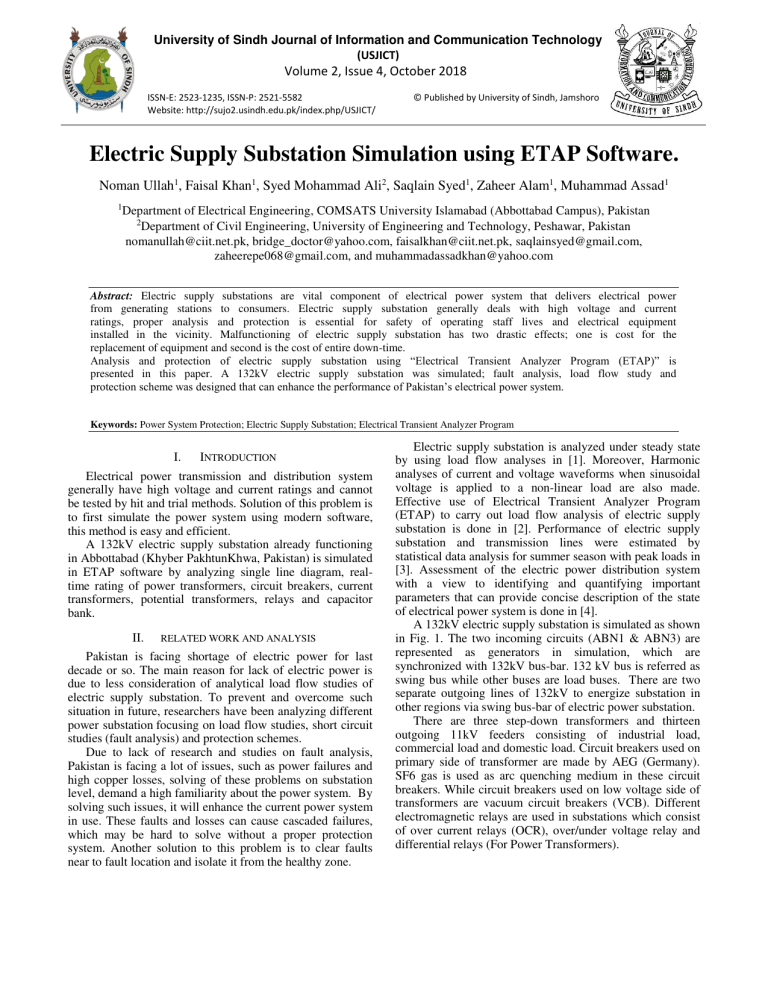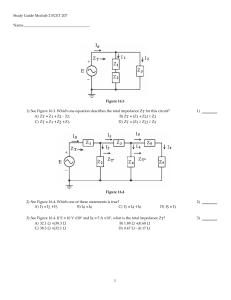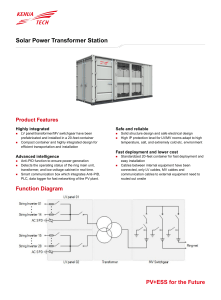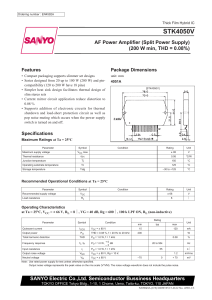
(c University of Sindh Journal of Information and Communication Technology (USJICT) Volume 2, Issue 4, October 2018 ISSN-E: 2523-1235, ISSN-P: 2521-5582 Website: http://sujo2.usindh.edu.pk/index.php/USJICT/ © Published by University of Sindh, Jamshoro Electric Supply Substation Simulation using ETAP Software. Noman Ullah1, Faisal Khan1, Syed Mohammad Ali2, Saqlain Syed1, Zaheer Alam1, Muhammad Assad1 1 Department of Electrical Engineering, COMSATS University Islamabad (Abbottabad Campus), Pakistan 2 Department of Civil Engineering, University of Engineering and Technology, Peshawar, Pakistan nomanullah@ciit.net.pk, bridge_doctor@yahoo.com, faisalkhan@ciit.net.pk, saqlainsyed@gmail.com, zaheerepe068@gmail.com, and muhammadassadkhan@yahoo.com Abstract: Electric supply substations are vital component of electrical power system that delivers electrical power from generating stations to consumers. Electric supply substation generally deals with high voltage and current ratings, proper analysis and protection is essential for safety of operating staff lives and electrical equipment installed in the vicinity. Malfunctioning of electric supply substation has two drastic effects; one is cost for the replacement of equipment and second is the cost of entire down-time. Analysis and protection of electric supply substation using “Electrical Transient Analyzer Program (ETAP)” is presented in this paper. A 132kV electric supply substation was simulated; fault analysis, load flow study and protection scheme was designed that can enhance the performance of Pakistan’s electrical power system. Keywords: Power System Protection; Electric Supply Substation; Electrical Transient Analyzer Program I. INTRODUCTION Electrical power transmission and distribution system generally have high voltage and current ratings and cannot be tested by hit and trial methods. Solution of this problem is to first simulate the power system using modern software, this method is easy and efficient. A 132kV electric supply substation already functioning in Abbottabad (Khyber PakhtunKhwa, Pakistan) is simulated in ETAP software by analyzing single line diagram, realtime rating of power transformers, circuit breakers, current transformers, potential transformers, relays and capacitor bank. II. RELATED WORK AND ANALYSIS Pakistan is facing shortage of electric power for last decade or so. The main reason for lack of electric power is due to less consideration of analytical load flow studies of electric supply substation. To prevent and overcome such situation in future, researchers have been analyzing different power substation focusing on load flow studies, short circuit studies (fault analysis) and protection schemes. Due to lack of research and studies on fault analysis, Pakistan is facing a lot of issues, such as power failures and high copper losses, solving of these problems on substation level, demand a high familiarity about the power system. By solving such issues, it will enhance the current power system in use. These faults and losses can cause cascaded failures, which may be hard to solve without a proper protection system. Another solution to this problem is to clear faults near to fault location and isolate it from the healthy zone. Electric supply substation is analyzed under steady state by using load flow analyses in [1]. Moreover, Harmonic analyses of current and voltage waveforms when sinusoidal voltage is applied to a non-linear load are also made. Effective use of Electrical Transient Analyzer Program (ETAP) to carry out load flow analysis of electric supply substation is done in [2]. Performance of electric supply substation and transmission lines were estimated by statistical data analysis for summer season with peak loads in [3]. Assessment of the electric power distribution system with a view to identifying and quantifying important parameters that can provide concise description of the state of electrical power system is done in [4]. A 132kV electric supply substation is simulated as shown in Fig. 1. The two incoming circuits (ABN1 & ABN3) are represented as generators in simulation, which are synchronized with 132kV bus-bar. 132 kV bus is referred as swing bus while other buses are load buses. There are two separate outgoing lines of 132kV to energize substation in other regions via swing bus-bar of electric power substation. There are three step-down transformers and thirteen outgoing 11kV feeders consisting of industrial load, commercial load and domestic load. Circuit breakers used on primary side of transformer are made by AEG (Germany). SF6 gas is used as arc quenching medium in these circuit breakers. While circuit breakers used on low voltage side of transformers are vacuum circuit breakers (VCB). Different electromagnetic relays are used in substations which consist of over current relays (OCR), over/under voltage relay and differential relays (For Power Transformers). University of Sindh Journal of Information and Communication Technology (USJICT), Vol.2(4), pg.: 176-179 Figure 1. Simulation of electric supply substation using ETAP Current transformer (CT) and Potential transformers (PT) are used in substation for metering and protection purposes. Capacitor bank is installed to improve power factor and load bus voltage. Magnitude of voltage on swing bus (bus 1 132kV) is 100% while due to voltage drops in other two outgoing transmission lines magnitude of voltage is not exactly 100%. The magnitude of voltage on 11kV buses can be 177 University of Sindh Journal of Information and Communication Technology (USJICT), Vol.2(4), pg.: 176-179 improved by installing capacitor bank in parallel with bus where in simulation rating of capacitor is 2400kvar. III. RESULTS AND DISCUSSION A. Load flow result analyses Load flow analysis of buses (Bus ID 1, 2, 3,4,5,7 used in simulation) is shown in Table 1 which shows rated voltage, real power and voltage across different buses. TABLE I. LOAD FLOW RESULT AT BUSES Bus ID Nominal kV Type Voltage MW Loading Bus 1 Bus 2 Bus 3 Bus 4 Bus 5 Bus 7 132 132 132 11 11 11 SWNG Load Load Load Load Load 100 95.58 98.82 99.04 99.68 98.91 138.854 112.776 1.641 7.759 4.175 7.801 Load flow analysis also shows actual data of real and reactive power, rated voltage, current and power factor of different loads as shown in Table 2. TABLE II. ID Bagnotar Cantt Dhamtor Kehal Load 1 Load 2 Load 3 N/Sher PMA Repco SDA Sherwan Spare Thandiyr Town Rating 2090 kVA 2068 kVA 1980 kVA 2178 kVA 154308 kVA 2000 kVA 1089 kVA 3256 kVA 990 kVA 2772 kVA 440 kVA 1540 kVA 2090 kVA 1188 kVA 1980 kVA Both Current Transformers (CTs) are set as input to differential relay and circuit breaker is set at output of differential relay. When fault current approaches the transformer, differential relay will operate causing opening of circuit breaker thus protecting transformer. Fig.2 shows fault at secondary of transformer and circuit breaker is tripped by differential relays installed with each transformer. Figure 2. Fault Current at Secondary of Transformer (T3) & Circuit Breaker (CB5) Opening If fault at 132 kV bus occurs, circuit breaker will operate through over current relays respectively and protect generators Gen 1 and Gen 2 (incoming lines) as shown in Fig. 3. LOAD RESULTS Rated kV kW kvar Amp % PF % Loading 11 1738 1077 108.5 85 98.9 11 1618 1214 107.4 80 98.9 11 1646 1020 102.8 85 98.9 11 1811 1122 113.1 85 98.9 132 112776 84582 645.1 80 95.6 132 1641 1060 8.645 84 98.8 11 855 641 56.61 80 99 11 2715 1682 169.3 85 99 11 785 589 51.74 80 99.6 11 2447 1185 144.1 90 99 11 393 190 22.99 90 99.6 11 1221 916 80.48 80 99.6 11 1743 1080 108.6 85 99 11 988 612 61.67 85 98.9 11 1668 1034 103.5 85 99.6 Fault analysis explained in paper is based on 3-phase balanced system (symmetrical fault). Power transformers is protected through differential relays, because differential relay compares the current at primary of transformer with current at secondary of transformer. Figure 3. Fault current at Bus 1 causing tripping of CB1 & CB2. Over current relay is simulated for tripping the circuit breaker, when Fault occurs on the feeder the protective relay is operated and protect the power system by isolating effected feeder from power system as shown in Fig. 4. In case of failure of primary protection, backup protection is very necessary. Primary protection failure can be due to failure of relay, trouble with wiring system or circuit breaker. Backup protection is explained as fault current occurs at feeder but protective relay installed on it has not operated, therefore backup relays operate after definite time delay and protect the system from fault current as shown in Fig. 5. Figure 4. Fault Current at Feeder & Circuit Breaker Opening 178 University of Sindh Journal of Information and Communication Technology (USJICT), Vol.2(4), pg.: 176-179 [2] [3] [4] Electrical and Electronics Engineering (ELECO), pp. 113-118, 5-8 November 2009. Rohit, K., “Load Flow Analysis of 132 kV substation using ETAP Software,” International Journal of Scientific & Engineering Research, Volume 4, Issue 2, February 2013. Muhammad, J. K., A. U. Rehman ,S. Mehmood , “ Performance Evolution of 132 kV grid stations and transmission lines in Peshawar Division . A case study,” First international conference on emerging trends in engineering, management and sciences, December 28-30, 2014, Peshawar, Pakistan. Kehinde, O., A. S. Oluwole, T. Adefarati, “A fault analysis of 11kV distribution system (a case study of ado Ekiti electrical power distribution district),” American journal of electrical power and Energy system, volume 3, Issue 2, pages 22-36, 2014. Figure 5. Fault Current at Feeder and Back up Protection IV. CONCLUSION Electric power supply without any interruption is most important for day-to-day growth of country. Different electrical components have been simulated, studied and analyzed with respect to their behavior in power system and impact of these equipment on power system when they fail to operate, which will help the reader to understand more about electric supply substaion and how those components work. Understanding of these components will be useful in case of expansion and converting conventional electric supply substations into smart substation. The short circuit analysis done in this paper will be used to understand differents scenarios in which real time faults could occur. The software used to simulate is user friendly and helpful to study and analyze power substations. REFERENCES [1] Rana, A. J. K., M. Junaid, M. M. Asgher, “Analysis and monitoring of 132 kV and using ETAP software.” International Conference on 179





